
The Argentine War of Independence was a secessionist civil war fought from 1810 to 1818 by Argentine patriotic forces under Manuel Belgrano, Juan José Castelli, Martin Miguel de Guemes and José de San Martín against royalist forces loyal to the Spanish crown. On July 9, 1816, an assembly met in San Miguel de Tucumán, declaring independence with provisions for a national constitution.
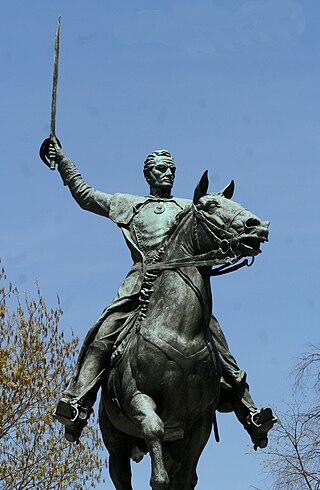
The military and political career of Simón Bolívar, which included both formal service in the armies of various revolutionary regimes and actions organized by himself or in collaboration with other exiled patriot leaders during the years from 1811 to 1830, was an important element in the success of the independence wars in South America. Given the unstable political climate during these years, Bolívar and other patriot leaders, such as Santiago Mariño, Manuel Piar, José Francisco Bermúdez and Francisco de Paula Santander often had to go into exile in the Caribbean or nearby areas of Spanish America that at the moment were controlled by those favoring independence, and from there, carry on the struggle. These wars resulted in the creation of several South American states out of the former Spanish colonies, the currently existing Venezuela, Colombia, Ecuador, Peru and Bolivia, and the now defunct Gran Colombia.
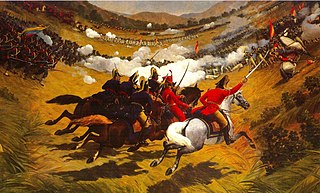
The Venezuelan War of Independence was one of the Spanish American wars of independence of the early nineteenth century, when independence movements in South America fought a civil war for secession and against unity of the Spanish Empire, emboldened by Spain's troubles in the Napoleonic Wars.
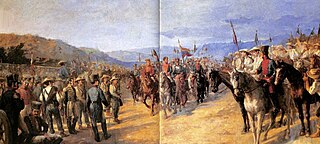
Bolívar's campaign to liberate New Granada also known as the Liberation Campaign of 1819 was part of the Colombian and Venezuelan wars of independence and was one of the many military campaigns fought by Simón Bolívar. In 1819 Bolívar led a combined New Granadan and Venezuelan Army in a campaign to liberate New Granada which had been under Spanish control since 1816.

The Battle of Boyacá (1819), also known as the Battle of Boyacá Bridge was a decisive victory by a combined army of Venezuelan and New Granadan troops along with a British Legion led by General Simon Bolivar over the III Division of the Spanish Expeditionary Army of Costa Firme commanded by Spanish Colonel José Barreiro. This victory ensured the success of Bolívar's campaign to liberate New Granada. The battle of Boyaca is considered the beginning of the independence of the north of South America, and is considered important because it led to the victories of the battle of Carabobo in Venezuela, Pichincha in Ecuador, and Junín and Ayacucho in Peru. New Granada acquired its definitive independence from the Spanish Monarchy, although fighting with royalist forces would continue for years.

Manuel Carlos María Francisco Piar Gómez was General-in-Chief of the army fighting Spain during the Venezuelan War of Independence.

José Antonio Anzoátegui (1789–1819) was a Venezuelan military officer who fought in the Venezuelan and Colombian Wars of Independence.

Santiago Mariño Carige Fitzgerald, was a nineteenth-century Venezuelan revolutionary leader and hero in the Venezuelan War of Independence (1811–1823). He became an important leader of eastern Venezuela and for a short while in 1835 seized power over the new state of Venezuela.
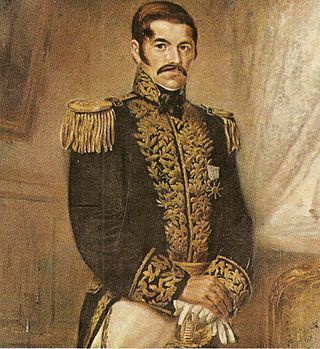
Felipe Luis Brión Detrox was a military officer who fought in the Venezuelan War of Independence. He rose to the rank of admiral in the navies of Venezuela and the old Republic of Colombia.
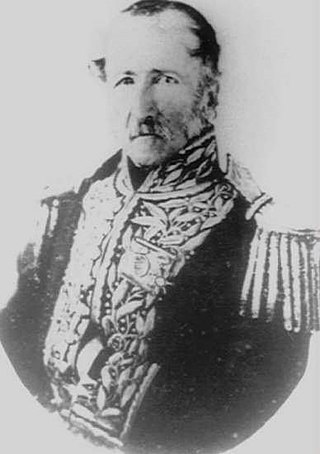
Joaquín París y Ricaurte was a Colombian military officer and politician who fought in the Colombian War of Independence and various civil wars that took place in Colombia during the 19th century. París was later also commander-in-chief of the army and Secretary of War on various occasions.

James Rooke (1770–1819) also known as Jaime Rooke or Jaime Rook was a British career soldier who fought in the Napoleonic wars and in the Venezuelan and Colombian wars of Independence.
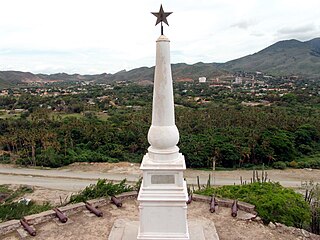
The Battle of Matasiete was a battle in the Venezuelan War of Independence that took place on 31 July 1817 near the city of La Asunción on Isla Margarita in Venezuela. It was fought between pro-independence Republican revolutionaries led by Francisco Esteban Gómez and Spanish Royalist forces under the command of Pablo Morillo. The outcome was a Spanish defeat.
The Battle of San Félix was an engagement in the Guayana campaign of the War of Independence of Venezuela, that occurred on 11 April 1817, on the mesa of Chirica in Province of Guayana, over the course of just half an hour.
The Battle of Urica took place during the War of Venezuelan Independence in the village of Urica on 5 December 1814, between the forces of Republican general in chief José Félix Ribas and Royalist caudillo José Tomás Boves. Although Boves died, the Royalists won the battle.

The American Confederation of Venezuela was an unrecognized state located in the Captaincy General of Venezuela of the Spanish Empire, which was organized by Venezuelan patriots following the Venezuelan Declaration of Independence.
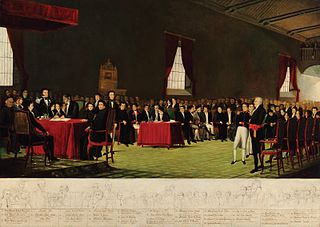
The Venezuelan independence was the juridical-political process that put an end to the ties between the Captaincy General of Venezuela and the Spanish Empire. It also implied the replacement of the absolute monarchy by the republic as the form of government in Venezuela.
The Battle of Clarines took place during the Venezuelan War of Independence. Royalist forces attacked a north-bound force from the Third Republic of Venezuela near the town of Clarines. The outnumbered and poorly armed Royalists secured a victory against the Patriot rebels.
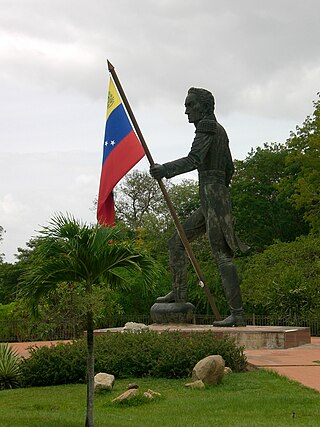
The Second Battle of Angostura was a military siege and confrontation that took place in the context of the Venezuelan War of Independence between Patriot and Royalist forces, that ended with victory for the Patriots, who managed to capture the city of Angostura on 17 July 1817.

Manuel Cedeño was an officer of the Venezuelan Patriot army who reached the position of Division General, who distinguished himself in the Venezuelan War of Independence.
The Battle of Pagallos, or, alternatively Pagayos, was a battle on 8 July 1817 during the Venezuelan War of Independence. In the battle, ships under Antonio Díaz carrying materiel to Simón Bolívar's Patriot army were attacked by eleven Royalist ships in the Orinoco, near the island of Pagallos. Patriots took heavy losses but successfully forced Royalists out of the Orinoco.















